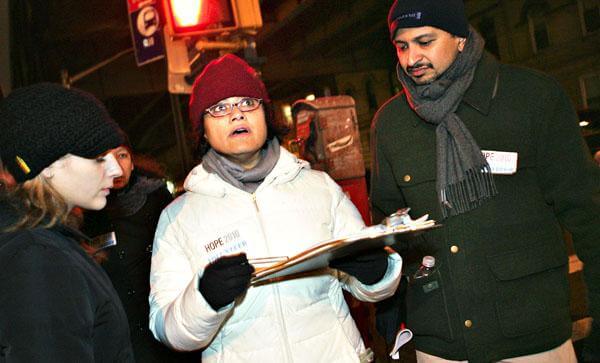By Connor Adams Sheets
Packs of city residents combed sections of Queens early Tuesday morning, pens and clipboards in hand, in search of the borough’s homeless population.
The volunteers were participants in Hope 2010, an annual survey that tracks the city’s homeless and tries to draw more of them off the street and into the safer comfort of shelters and other available services.
Coordinated by the city Department of Homeless Services, several dozen people from across the city gathered in a large room at LaGuardia Community College in Long Island City at 10:30 p.m. Monday.
The surveyors were split into groups; given a quick overview of the art of counting populations; handed maps, questionnaires and other necessary materials; and sent to their assigned neighborhoods to ask everyone they see a list of questions about their housing status.
“Ask every person if they’re homeless. Ask every homeless person if they’d like to come into a shelter tonight,” said Danielle Minelli, director of street homelessness solutions for the DHS, during the training session. “We want to respect people who are sleeping outside if they choose to. It’s every person’s right to sleep on the street, just remember that.”
At 12:15 a.m. Tuesday, the groups fanned out across the borough to areas, including Astoria, Long Island City, Jackson Heights and Woodside, where they began the tedious task of walking both sides of the streets they had been assigned in search of human bodies.
Shampa Chanda and V.S. Mani, both of Long Island City, and Gloria Rivera, of Maspeth, made up a group assigned to canvass downtown Long Island City.
On a night punctuated with short bursts of light rain, the three volunteers made their way through a Nevada-shaped area of the map located below the towering CitiBank building.
Rivera was the first questioner of the night when the group came across a Jackson Heights resident in a blue beanie and matching Nike jacket who was walking under the elevated train tracks on 23rd Street.
Rivera ran down the list of questions on the DHS survey, speaking Spanish at the man’s request, and determined that he was not homeless. After recording the results of their conversation for the department’s use, the group strolled onward.
Shampa said this was her first time taking part in the survey and that she hoped her participation might help the less fortunate.
“I just wanted to experience it. I wanted to know where the homeless population lives and what conditions they are living in in the streets,” she said.
Hope 2005, the first citywide survey the DHS undertook, indicated that 4,395 individuals were living unsheltered in the city. Hope 2009 revealed the number had fallen 47 percent since 2005 to 2,328 individuals.
Cory Edelson, director of special projects with the DHS, said much of the decrease could be attributed to homeless individuals being connected with shelters and other city services and finding ways to live more independently.
“The people who are on the streets are often very mentally ill or addicted to substances,” she said. “The idea is you bring them into a warm place and then they might be more amenable to talking and getting services.”
Reach reporter Connor Adams Sheets by e-mail at csheets@cnglocal.com or by phone at 718-229-0300, Ext. 138.




























